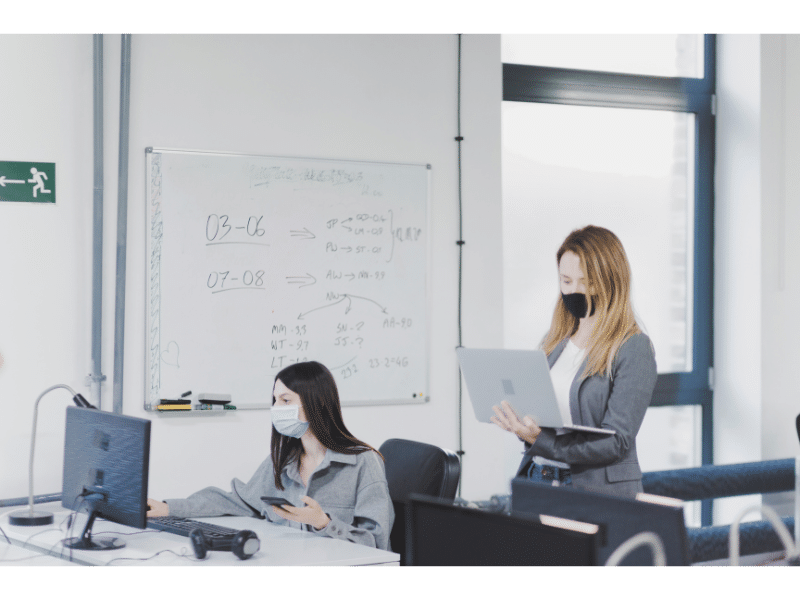The CDC states that COVID-19 can be spread through the air and ‘in general, indoor environments without good ventilation increase this risk’. This risk is a call to action for building operators in workplaces, schools and public buildings to mitigate the spread of the coronavirus through indoor ventilation systems. One of ASHRAE’s COVID-19 mitigation recommendations is to increase outdoor airflow rate as much as possible. It is important to understand the operational impact of this change before implementation. We developed a free tool to help understand these impacts.
Impacts of Preventing COVID through Ventilation
Astute building operators know that increasing outside airflow into a building, especially when it is hot, cold, or humid outside, could make it uncomfortable if the HVAC systems can’t “keep up.” This can lead to excess energy consumption, occupant discomfort, and conditions of low humidity and/or low temperatures that allow viruses, including SARS-CoV-2 (coronavirus), to live longer in the air[1], potentially negating the very mitigation efforts you’re trying to enact.
To help building operators around the country understand how far they can push their outside airflow rate before they start to lose control of building temperature and humidity, we updated our Outside Air Ventilation Load Calculator to include weather data for all US ASHRAE climate zones.
Building operators may find the desired outdoor airflow rate unachievable without significant negative impacts on energy use, comfort, and indoor air quality. These limitations are a key reason why it is important to prioritize complimentary mitigation strategies for safer indoor air. Increased air filtration using MERV-13 filters, HVAC maintenance, an enforced mask policy and social distancing play big roles in reducing the spread of COVID-19, which can also be better understood using our other free calculator which calculates the probability of infection.
Calculating HVAC Performance with Increased Outdoor Airflow Rates
This updated version of our Ventilation Load Calculator provides a quick tool for building operators to understand critical information on how their building performs at various outdoor airflow rates, and how far they can push the limits of their outside airflow before losing control of the temperature or moisture in the space. Our tool can help you estimate:
- Unmet Heating Hours – How many hours per year that the building cannot maintain heating set points.
- Unmet Cooling Hours – How many hours per year the building cannot maintain cooling set points.
- Maximum and minimum outside air temperatures that their building can handle before losing the ability to maintain design space temperature.
- Maximum temperature and humidity range that the building can handle before losing the ability to maintain dry indoor air.
Our intent for this tool is to help building operators make informed decisions about how far they can push outside airflow rates to protect their occupants from COVID-19 while maintaining occupant comfort, and safe indoor temperature and humidity conditions.
Example
The calculation tool has a full set of instructions. To illustrate how it works, here’s an example to assess a building’s capability to increase outside airflow.
Required Building Inputs
First, you need to input a few simple building parameters. These include the design outside air flow rate (%), Reference City, and Weekly Schedule. In this case, let’s use the following example inputs:
- Design OA Condition – 15% (15-30% is typical)
- Reference City – Houston, TX
- Weekly Schedule – 7a – 7p, M-F
Understanding the Interface
The calculator will display a typical year of weather data in this location, overlayed on a psychrometric chart. All of the data in blue represents hours when a building can successfully maintain space conditions. Red data points indicate unmet heating or cooling hours. Typically, buildings are designed to have 1% unmet hours or fewer. You can see the design conditions, and the unmet heating/cooling hours at the current outside air fraction, in the tables on the right.
 Figure 1 – Example Calculation at Design Conditions (15% Outside Air)
Figure 1 – Example Calculation at Design Conditions (15% Outside Air)
Testing Impacts of Different Outside Air Fractions
To test the impact of changing the outside air fraction, you can simply move the slider or input a custom outside air fraction between 0 and 100% of total supply flow. The calculator will update to show how the number of unmet cooling and heating hours changes at the new outside air fraction[2]. In this case, we changed the outside air fraction to 30%, and can see the following results:
- Unmet cooling hours increased dramatically to 41%! Clearly it will be difficult to cool this building under many outdoor air conditions.
- Unmet heating hours increased slightly, to 6%. This will still result in some uncomfortable conditions at low outside air temperatures (below 50 °F, as-read from the results), but should be of lesser concern compared to the cooling.
- From the Psychrometric Chart you can see the significantly expanded region of red data in the top right corner of the plot. In all of these weather conditions you will either not be able to keep the building cool, or dry, or both. For example, you can tell by looking at the temperature on the x axis, and the relative humidity on the curved lines, that even in conditions as low as 72 °F (approx.), if the relative humidity is 100% (such as on a warm stormy day), you will not be able to keep my building cool and dry at this outside airflow rate.
 Figure 2 – Example Calculation at 30% Outside Airflow
Figure 2 – Example Calculation at 30% Outside Airflow
Understanding Outputs
In general, based on these results, increasing outside airflow to 30% would not be recommended. There is only a narrow band of weather conditions in which this building could operate comfortably at 30% outside air.
For this building, operators would need to reduce outside airflow back to the 15% design flow nearly ½ of the year. This includes any time outdoor air temperature dropped below 50 °F, climbed above 95°F, or when the weather got humid or rainy with temperatures above 72 °F. Otherwise the building will not maintain comfortable and safe conditions.
You can learn more about how to use the tool in the video below.
Implementing such a rigorous control strategy would cause significant burden to maintenance staff and likely impact occupant comfort. Though, it is possible to automate some of these efforts using an advanced building automation system and local sensor data for outside air temperature and relative humidity. But there is more to consider than just logistics.
Energy Impacts
We have not even begun to discuss the energy and cost implications of increasing the outside airflow rate. Even in weather conditions when the HVAC system can keep up with the load, there are many conditions where increased outside airflow will drive up energy consumption significantly. Therefore, before making any changes to the outside airflow rate, we recommend considering other mitigation strategies.
Preventing COVID through Indoor Ventilation
There is a lot to consider when trying to prevent the spread of COVID-19 indoors through ventilation systems. You can examine the impacts of other mitigation strategies by estimating the probability of infection using our other free calculator which tests the relative impact of increasing outdoor airflow against other efforts (such as upgrading air filtration, implementing mask policies, UV treatment, etc.). To understand the science behind the infection calculator, you can read our whitepaper which explains the application of the Wells-Riley equation. If you need assistance evaluating mitigation strategies and/or implementing them, contact us anytime through our website or give us a call at 510.834.6420.
[1] https://www.dhs.gov/science-and-technology/sars-airborne-calculator
[2] The calculator assumes the equipment capacity is sufficient to meet the loads of the building at the design outside air ventilation rate.


